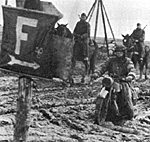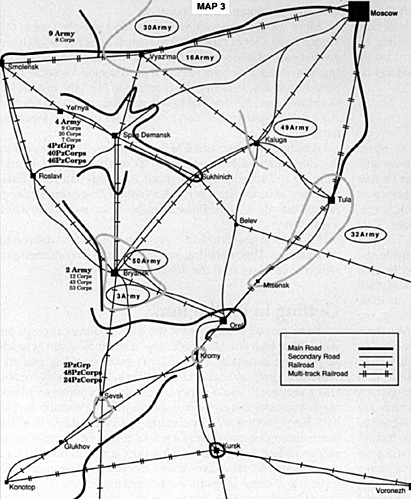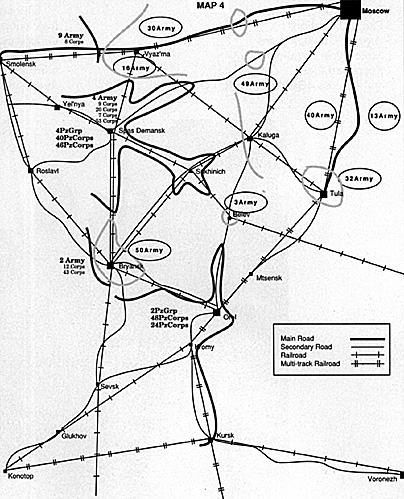[Ed. note: This article concludes Lynn's interesting comparison of the historical event of Taifun with a playing of Guderian's Blitzkrieg. Part 1 appeared in Operations 29.]
28-30 Sept. 1941 Game Turn 3
 (see map 3: positions at start GT3)
(see map 3: positions at start GT3)
Soviet Player - situation and planning
At the end of Game Turn 2, Soviet units were scattered. No supplied, in-command Soviet units existed south of the immediate area of Bryansk. Thirteen divisions, two Army HQs (3 and 50) and several non-divisional units were cut off in Bryansk. North of them the next body of Soviet units were grouped around Vyazma.
The Soviet player planned to organize the defense of Bryansk and withdraw units from 30 and 16 Armies to reinforce the defense closer to Moscow. The key objective for turn 3 was to build a defense in Kaluga and Tula while blocking all road access routes to Moscow to prevent any German attempt at a coup de main.
German Player - situation and planning
 The German player received good news and bad news in Game Turn 2. The good news was the continuing destruction of Soviet HQ units and the resulting fragmenting of Soviet defenses. The bad news was a Soviet tank brigade sitting in Kromy and two out-of-fuel Soviet tank divisions blocking supply access between Orel and the German supply head. Further bad news was the destruction of a German Panzer Corps headquarters.
The German player received good news and bad news in Game Turn 2. The good news was the continuing destruction of Soviet HQ units and the resulting fragmenting of Soviet defenses. The bad news was a Soviet tank brigade sitting in Kromy and two out-of-fuel Soviet tank divisions blocking supply access between Orel and the German supply head. Further bad news was the destruction of a German Panzer Corps headquarters.
German on-map-supply was lower at the start of each game turn. The German player had to decide this turn either to fuel and commit mobile forces for a dash on Moscow or to eliminate Bryansk and build up supply for a more deliberate advance on Moscow. There was not enough supply to reduce the Bryansk pocket and drive toward the Soviet capital. He chose to continue the advance on Moscow with mobile units. Infantry units would compress the pocket around Bryansk and protect the north and south flanks. Mobile units would move forward to concentrate on Orel (24 Panzer Corps) and Sukhinich (40 Panzer Corps). Captured airfields at Orel and Spas Demansk would be upgraded to level 2.
Game Operations Narrative - Game Turn 3
The last days of September brought continuing sunny skies and dry roads. The badly stretched German logistics network focused supply delivery to Konotop to provide fuel for concentrating Second Panzer Group mobile units forward to Orel.
German attacks succeeded in clearing all Soviet units remaining on or south of the Orel road and west of Kursk. 4 Panzer attacked and destroyed 10 and 69 Tank divisions while 17 Panzer destroyed the tank brigade in Kromy. Engineers from 24 Panzer Corps repaired and upgraded the facilities at Orel airfield. 35 Corps road marched to Sevsk en route to Kursk and the deep right flank of Second Panzer Group.
In the north German operations were constrained to limited redeployment by lack of fuel. 40 Panzer Corps headquarters moved to the Spas Demansk airfield while 2 Panzer, 5 Panzer, 10 Panzer and 3 Motorized divisions remained on the road to Sukhinich. 11 Panzer division was assigned to this panzer concentration as its units passed through Roslavl on approach march. 53 Corps headquarters was removed from the static front on the Desna west of Bryansk and moved to Spas Demansk. This headquarters was assigned to 4 Army to extend the north flank defenses. Reassignment of this headquarters allowed the concentration of 7 Corps with three divisions (78 Assault, 73 Infantry, 292 Infantry) for an advance toward Yukhnov and Kondrovo.
Soviet 3 Army headquarters with 108 Tank and a Katyusha brigade slipped through the still forming German perimeter around Bryansk and moved to Belev. 50 Army destroyed the airfield at Karachev and withdrew to a defense perimeter closer to Bryansk.
In Moscow two new Army headquarters units were assembled (13 and 40 Army) and sent to blocking positions at Stupino (13 Army) and Serpukhov (40 Army). 32 Army at Tula withdrew the advanced Soviet units at Mtsensk. Other units of 32 Army were transferred to 49 Army to bolster Soviet defenses west of Kaluga. The airfield facilities at Kaluga were expanded by engineer units of 49 Army.
In air operations at the end of September, the Luftwaffe failed to provide fighter cover for spearhead units at Sukhinich. Soviet air units attacked 2 Panzer, 5 Panzer and 3 Motorized divisions. The German divisions did not lose any units, but 5 Panzer was disorganized by the Soviet air assault.
 (see map 4: positions at end GT3)
(see map 4: positions at end GT3)
Historical Operations Commentary (7-9 Oct.)
German operations in 2nd Panzer Army were trying to open a supply line Roslavl-Bryansk-Orel. Fuel shortages were such that units of 48 Panzer were advancing on foot toward Dmitriev. North of 2nd Panzer Army 2nd Army captured Sukhinich on 7 October. And farther north still 4th Army and 9th Army met to close the encirclement of Vyazma, enveloping 45 Soviet formations. On this date, Army Group Center command proposed a 2nd Panzer Army advance beyond Tula to seize crossings over the Oka at Serpukhov.
8 October started with 4 Panzer preparing to move against a Soviet infantry division and tank brigade at Mtsensk. Left of 4 Panzer, 3 Panzer was advancing toward Bolkhov south of Belev. Guderian mentions that commanders and troops were exhausted after more than a week of offensive activity and were facing increasing pressure from Soviet units. Soviet units attempted to break out of the Bryansk encirclement and 35 Corps reported increased Soviet pressure north and west of Sevsk.
On 9 October 293 Infantry was attacked by units in the Bryansk pocket and Infantry Regiment 41 of 10 Motorized was called to close the gap opened between 293 Infantry and 29 Motorized. Also in Bryansk 13 Army staff broke out of the encirclement. 2nd Panzer Army headquarters reached Dmitrovsk in a heavy snowstorm and Guderian noted that "ÉCountless vehicles were stuck."
Final Summary
How do three game turns compare with ten days of history? For the three turns described above, they match the historical events very closely. In 1941 the Soviet front was broken south of Bryansk, pockets had been formed around Bryansk and Vyazma, and German units were attempting to advance through Belev and Mtsensk toward Kaluga and Tula. With the exception of the Vyazma pocket (which required 9 Army units off the map to the north) this is the game situation at the end of 3 turns.
You may say this situation arises because the players know history and strive to recreate it. However, actions described in the narrative are sound game play. The OCS requires players to make game decisions which can produce results similar to historical events. I do not claim that the players did not know the history of the battle. I do claim that after the choice of historical unit start positions, the players played with the intention to make good game moves. OK, grant that three game turns yielded a situation similar to the same historical ten day time span. Does this mean that this game will continue to mirror history? Unfortunately, as this article is written this game is still in progress and the final decision has not been reached. However, some results from the first three turns and operations in subsequent turns indicate that the German player may take Moscow: clearly not the historical result.
The German player deliberately targeted unprotected Soviet HQ units in his first turn assault. In the game, destruction of Soviet 24, 43, 33 and 13 Army HQ and the elimination of supply trace for 40 Army resulted in large Soviet unit losses due to supply failure. At the end of 3 game turns Soviet losses were:
-
5 Army HQ units
4 Tank divisions
20 Rifle divisions
4 Tank brigades
4 Artillery brigades
1 Cavalry brigade
and German losses were:
-
1 Panzer Corps HQ unit
3 Panzer battalions
3 Assault Gun battalions
1 Motorcycle battalion
1 Recce battalion
(total AR loss = 3x5AR; 4x4AR; 1x3AR)
Such a large loss of Soviet units is historical, since these losses can represent disintegration as well as destruction of Soviet units which occurred at this point in the war. But the game mechanism for this loss is directly linked to the destruction of HQ units. This number of HQ unit losses was a severe handicap to the Soviet player in subsequent game turns. The German player's operational choices were also limited by available supply after the first game turn. This result is intentional in the OCS and is also in agreement with an historical record which mentions supply problems and fuel shortages. However, the historical record also mentions degradation in German units' offensive power due to losses. The small level of unit losses leaves German offensive power almost completely intact and the German player's operational freedom is only limited by supply and possibly weather.
One final consideration is simple variability. Every game unfolds as the result of numerous player decisions and die rolls. Thus the outcome will vary depending on the sum of these events. An answer to the question "Does the OCS system recreate historically similar events?" would require a collection of similar playthroughs and careful comparison of the collection of results.
Ultimately the answer for different players will depend on their subjective feel for how their game results mirror their understanding of history. The discussions will continue on gamers-l and in the pages of Operations. This article is just one more log on the fire, and perhaps it will continue to stir the discussion.
More Guderian
Back to Table of Contents -- Operations #30
Back to Operations List of Issues
Back to MagWeb Master List of Magazines
© Copyright 1998 by The Gamers.
This article appears in MagWeb (Magazine Web) on the Internet World Wide Web.
Other military history articles and gaming articles are available at http://www.magweb.com